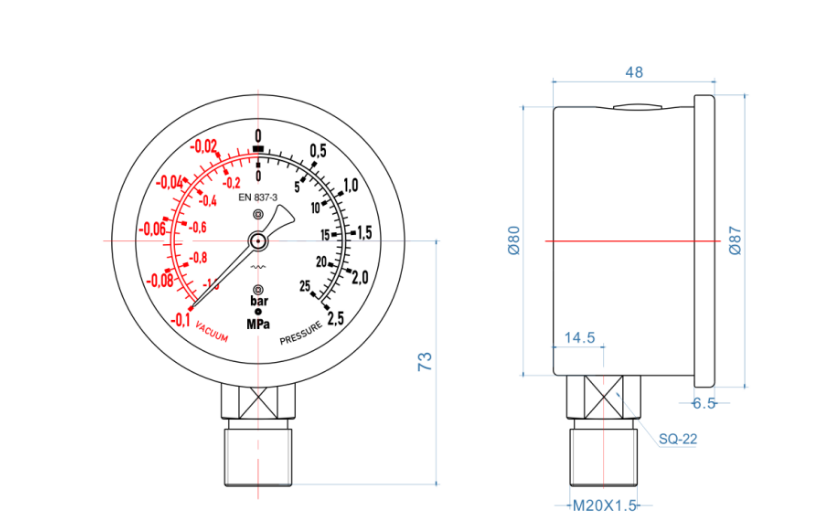
Nov . 07, 2024 10:15 Back to list
Medical Oxygen Pressure Gauge for Accurate Monitoring and Safety in Healthcare Environments
Understanding Medical Oxygen Pressure Gauges A Crucial Component in Healthcare
Medical oxygen is an essential therapeutic gas used in various healthcare settings to ensure patients receive the necessary support for their respiratory needs. Whether it’s for patients with chronic obstructive pulmonary disease (COPD), asthma attacks, or during surgical procedures, the effective delivery of medical oxygen relies heavily on precise monitoring, which is where oxygen pressure gauges come into play. This article explores the importance of medical oxygen pressure gauges, their functionality, and factors to consider when selecting the right gauge for healthcare facilities.
The Importance of Medical Oxygen Pressure Gauges
Medical oxygen pressure gauges are specialized instruments designed to measure the pressure of oxygen in medical cylinders or systems. Accurate pressure readings are crucial for healthcare providers to determine how much oxygen is available for patient use. An underfilled cylinder could lead to inadequate oxygen supply during critical moments, while an overpressure situation might damage delivery systems or pose safety risks. Therefore, these gauges ensure that clinicians can maintain optimal oxygen saturation levels, which is vital for patient recovery and overall health.
How Medical Oxygen Pressure Gauges Work
Typically, medical oxygen pressure gauges consist of two main components the pressure sensor and the display. The pressure sensor is connected to the oxygen cylinder and measures the gas pressure inside. This information is then transmitted to the display, which shows the pressure in various units, often in psi (pounds per square inch) or bar.
Most medical oxygen pressure gauges are designed with certain features that enhance their usability, such as
1. Color-Coded Readings Many gauges are color-coded, providing a quick visual reference for pressure levels. A green zone usually indicates safe and ample oxygen supply, while yellow or red zones signal low pressure, prompting immediate action.
2. Mechanical and Digital Options These gauges come in mechanical (analog) and digital forms. While mechanical gauges rely on traditional needle indicators, digital gauges offer more precise readings and are easier to read, especially in low-light situations.
medical oxygen pressure gauge product

Selecting the Right Medical Oxygen Pressure Gauge
When choosing a medical oxygen pressure gauge, several factors should be taken into account
1. Accuracy The precision of pressure readings is paramount in a medical context. Look for gauges with a reputation for reliability and accuracy to ensure optimal patient care.
2. Compatibility Ensure that the chosen gauge is compatible with the type of oxygen delivery system or cylinder used in your facility. Different equipment may require specific fittings.
3. Ease of Use For busy medical environments, it's crucial that the gauges are user-friendly. Consider features such as clear displays and intuitive designs that facilitate quick assessment and response.
4. Maintenance and Calibration Regular maintenance and calibration are necessary for the long-term performance of pressure gauges. Choose models that are easy to service to maintain accuracy.
5. Cost and Warranty While price shouldn't compromise quality, it’s essential to find a balance. Investing in quality medical equipment often saves costs associated with replacements and repairs.
Conclusion
Medical oxygen pressure gauges play an integral role in ensuring that oxygen delivery systems operate correctly and safely in healthcare settings. By understanding their importance and functionality, healthcare providers can select the appropriate gauges that meet their facilities’ needs, ultimately ensuring better patient care. As advancements in technology continue to emerge, the future of medical oxygen pressure monitoring looks promising, poised to enhance safety and effectiveness in oxygen therapy.
-
High-Precision 5 Valve Manifold Differential Pressure Gauge Suppliers
NewsApr.29,2025
-
High-Precision Diaphragm Vacuum Pressure Gauges Manufacturers & Quotes
NewsApr.29,2025
-
Omega Differential Pressure Gauges High Accuracy & Durability
NewsApr.28,2025
-
Low Pressure Differential Pressure Gauges Precision Solutions & Quotes
NewsApr.28,2025
-
Digital Diaphragm Pressure Gaauge Precision Measurement & OEM Quotes
NewsApr.28,2025
-
Differential Pressure Gauge China Price High-Accuracy & Best Quotes
NewsApr.28,2025
